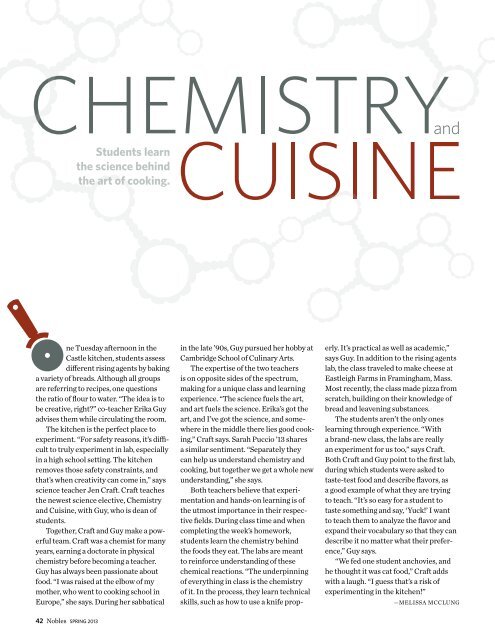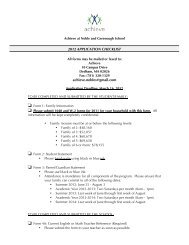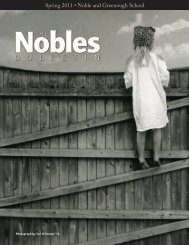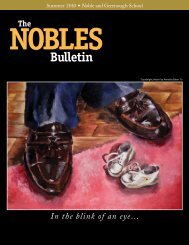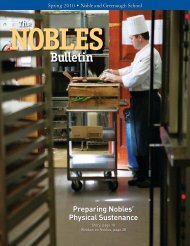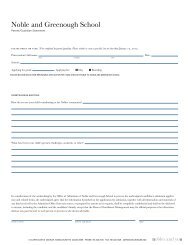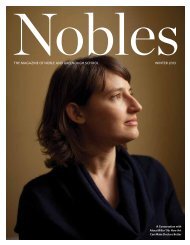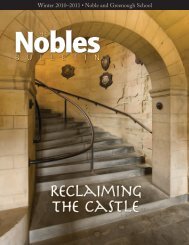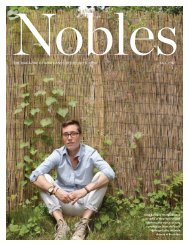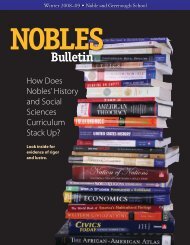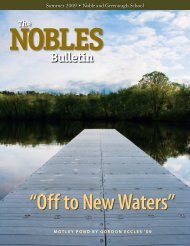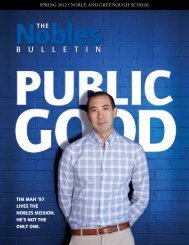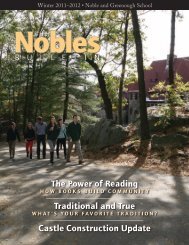download the PDF version - Noble and Greenough School
download the PDF version - Noble and Greenough School
download the PDF version - Noble and Greenough School
Create successful ePaper yourself
Turn your PDF publications into a flip-book with our unique Google optimized e-Paper software.
Students learn<strong>the</strong> science behind<strong>the</strong> art of cooking.<strong>and</strong>ne Tuesday afternoon in <strong>the</strong>Castle kitchen, students assessdifferent rising agents by bakinga variety of breads. Although all groupsare referring to recipes, one questions<strong>the</strong> ratio of flour to water. “The idea is tobe creative, right?” co-teacher Erika Guyadvises <strong>the</strong>m while circulating <strong>the</strong> room.The kitchen is <strong>the</strong> perfect place toexperiment. “For safety reasons, it’s difficultto truly experiment in lab, especiallyin a high school setting. The kitchenremoves those safety constraints, <strong>and</strong>that’s when creativity can come in,” saysscience teacher Jen Craft. Craft teaches<strong>the</strong> newest science elective, Chemistry<strong>and</strong> Cuisine, with Guy, who is dean ofstudents.Toge<strong>the</strong>r, Craft <strong>and</strong> Guy make a powerfulteam. Craft was a chemist for manyyears, earning a doctorate in physicalchemistry before becoming a teacher.Guy has always been passionate aboutfood. “I was raised at <strong>the</strong> elbow of mymo<strong>the</strong>r, who went to cooking school inEurope,” she says. During her sabbaticalin <strong>the</strong> late ’90s, Guy pursued her hobby atCambridge <strong>School</strong> of Culinary Arts.The expertise of <strong>the</strong> two teachersis on opposite sides of <strong>the</strong> spectrum,making for a unique class <strong>and</strong> learningexperience. “The science fuels <strong>the</strong> art,<strong>and</strong> art fuels <strong>the</strong> science. Erika’s got <strong>the</strong>art, <strong>and</strong> I’ve got <strong>the</strong> science, <strong>and</strong> somewherein <strong>the</strong> middle <strong>the</strong>re lies good cooking,”Craft says. Sarah Puccio ’13 sharesa similar sentiment. “Separately <strong>the</strong>ycan help us underst<strong>and</strong> chemistry <strong>and</strong>cooking, but toge<strong>the</strong>r we get a whole newunderst<strong>and</strong>ing,” she says.Both teachers believe that experimentation<strong>and</strong> h<strong>and</strong>s-on learning is of<strong>the</strong> utmost importance in <strong>the</strong>ir respectivefields. During class time <strong>and</strong> whencompleting <strong>the</strong> week’s homework,students learn <strong>the</strong> chemistry behind<strong>the</strong> foods <strong>the</strong>y eat. The labs are meantto reinforce underst<strong>and</strong>ing of <strong>the</strong>sechemical reactions. “The underpinningof everything in class is <strong>the</strong> chemistryof it. In <strong>the</strong> process, <strong>the</strong>y learn technicalskills, such as how to use a knife properly.It’s practical as well as academic,”says Guy. In addition to <strong>the</strong> rising agentslab, <strong>the</strong> class traveled to make cheese atEastleigh Farms in Framingham, Mass.Most recently, <strong>the</strong> class made pizza fromscratch, building on <strong>the</strong>ir knowledge ofbread <strong>and</strong> leavening substances.The students aren’t <strong>the</strong> only oneslearning through experience. “Witha br<strong>and</strong>-new class, <strong>the</strong> labs are reallyan experiment for us too,” says Craft.Both Craft <strong>and</strong> Guy point to <strong>the</strong> first lab,during which students were asked totaste-test food <strong>and</strong> describe flavors, asa good example of what <strong>the</strong>y are tryingto teach. “It’s so easy for a student totaste something <strong>and</strong> say, ‘Yuck!’ I wantto teach <strong>the</strong>m to analyze <strong>the</strong> flavor <strong>and</strong>exp<strong>and</strong> <strong>the</strong>ir vocabulary so that <strong>the</strong>y c<strong>and</strong>escribe it no matter what <strong>the</strong>ir preference,”Guy says.“We fed one student anchovies, <strong>and</strong>he thought it was cat food,” Craft addswith a laugh. “I guess that’s a risk ofexperimenting in <strong>the</strong> kitchen!”—Melissa McClung42 <strong>Noble</strong>s spring 2013


